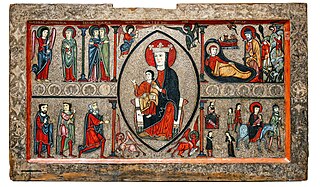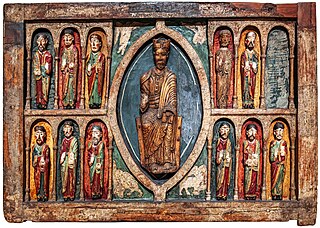
The Museu Nacional d'Art de Catalunya, abbreviated as MNAC, is a museum of Catalan visual art located in Barcelona, Catalonia, Spain. Situated on Montjuïc hill at the end of Avinguda de la Reina Maria Cristina, near Pl Espanya, the museum is especially notable for its outstanding collection of romanesque church paintings, and for Catalan art and design from the late 19th and early 20th centuries, including modernisme and noucentisme. The museum is housed in the Palau Nacional, a huge, Italian-style building dating to 1929. The Palau Nacional, which has housed the Museu d'Art de Catalunya since 1934, was declared a national museum in 1990 under the Museums Law passed by the Catalan Government. That same year, a thorough renovation process was launched to refurbish the site, based on plans drawn up by the architects Gae Aulenti and Enric Steegmann, who were later joined in the undertaking by Josep Benedito. The Oval Hall was reopened for the 1992 Summer Olympic Games, and the various collections were installed and opened over the period from 1995 to 2004. The museum was officially inaugurated on 16 December 2004. It is one of the largest museums in Spain.

The Batlló Majesty is a large 12th-century Romanesque wooden crucifix, now in the National Art Museum of Catalonia in Barcelona, Spain. It is one of the most elaborate examples in Catalonia of an image of Christ on the Cross, symbolizing his triumph over death.

The Altar frontal from La Seu d'Urgell or of The Apostles is a Romanesque altar frontal currently exhibited at the National Art Museum of Catalonia, Barcelona, Spain. The work dates from the second quarter of the 12th century and comes from a church of the Bishop of La Seu d'Urgell and was acquired in 1905. It is one of the masterpieces of the collection of panel painting of the MNAC. The frontal, the item covering the front of the altar, stands out for the quality of its bright colours and because it illustrates some of the characteristics of composition in Romanesque art, such as bilateral symmetry, abstraction of the background, with no reference to space or context, and the unnatural geometrical treatment of form to be observed in the folds of the clothing. It also shows certain conventions of representation, such as so-called hierarchical perspective, which consists in representing the chief character in a larger size.

The Altar frontal from Avià is a rare Romanesque altar frontal exhibited at the National Art Museum of Catalonia in Barcelona. It is the front of the altar of the church of St. Mary of Avià, in the county of Berguedà, later moved to MNAC Barcelona, while the church has a replica in place. It is dated to the 13th century or earlier, and was painted by an unknown artist.

The Southern apse from Pedret is a Romanesque fresco painting from late 11th century or the beginning of the 12th century, which was acquired during the 1919-1923 campaign of the Junta de Museus. The artwork originated from the southern apsidiole of the Church of Sant Quirze de Pedret and is currently exhibited in the Romanesque Art collection at the Museu Nacional d'Art de Catalunya, in Barcelona, Spain.

The Apse of Santa María d'Àneu is a romanesque apse of the church of Santa Maria, Àneu, created in the late 11th century or early 12th century, the transferred frescos from which are now exhibited at Museu Nacional d'Art de Catalunya, in Barcelona. The decoration of the apse of the church of Santa María d’Àneu combines themes and motifs from the Old and New Testaments. Originally painted at the Church of Santa María d’Àneu

The paintings from Arlanza are a set of frescos belonging to the mural decoration of a Benedictine monastery of San Pedro de Arlanza, in the Province of Burgos, Castile and León, Spain, dating to around 1210, and now dispersed among a number of collections. The Spanish government began to detach and sell sections of the frescos in the 19th century, though less exciting sections remain in situ. In 1943, the largest group of six major fragments was moved to the National Art Museum of Catalonia of Barcelona. Most of the Romanesque mural painting that has survived is of religious subjects. There was also fine decorations of a courtly or profane nature in large monastic centres, such as Arlanza in Castile, and these fragments represent especially rare survivals. According to C. R. Dodwell, the "imposing" Arlanza paintings are "endowed with all the power and grandeur of Romanesque at its best".

The Apse of Sant Climent de Taüll is a Romanesque fresco in the National Art Museum of Catalonia, Barcelona. The fresco is one of the masterpieces of the European Romanesque, from which the unknown Master of Taüll takes his name. It was painted in the early 12th century in the church of Sant Climent de Taüll in the Vall de Boí, Alta Ribagorça in the Catalan Pyrenees. The mural covered the apse of the church. In 1919-1923 it was moved, along with other parts of the fresco decoration, to Barcelona, in an attempt to preserve the murals in a stable, secure museum setting.

Erill la Vall Descent from the Cross is a set of seven 12th-century wooden sculptures from the Pyrenees village of Erill la Vall in Catalonia. Originally painted, it comprises a complete Romanesque Descent from the Cross sculpture group, which in Catalonia has the peculiarity that it is made up of seven figures. Two of the carvings are kept at the National Art Museum of Catalonia (MNAC) and the rest at the Vic Episcopal Museum.

Saint Candidus is a painting by Ayne Bru, conserved at the National Art Museum of Catalonia.

The Martyrdom of Saint Bartholomew is a painting by Jusepe de Ribera conserved at the National Art Museum of Catalonia.

The Altar frontal from Tavèrnoles is Romanesque altar frontal exhibited at the National Art Museum of Catalonia in Barcelona.

The Apse from La Seu d'Urgell is an apse exhibited at the National Art Museum of Catalonia in Barcelona.

The Apostles from Àger is a painting created in the late 11th century or early 12th century, currently exhibited at the National Art Museum of Catalonia in Barcelona.

The Baldachin from Tost is a painted baldachin exhibited at the National Art Museum of Catalonia in Barcelona.

The Virgin from Ger is a 12th century sculpture exhibited at the National Art Museum of Catalonia in Barcelona.

The Paintings from Santa Maria in Taüll are a set of frescos conserved at the Museu Nacional d'Art de Catalunya, in Barcelona.

The Altar frontal from Cardet is an altar conserved at the Museu Nacional d'Art de Catalunya, in Barcelona.

The Altar frontal from Santa Maria in Taüll is an altar frontal exhibited at the National Art Museum of Catalonia in Barcelona.

The Christ from 1147 is a Catalan wood sculpture from the 12th-century, exhibited at the National Art Museum of Catalonia in Barcelona.





















